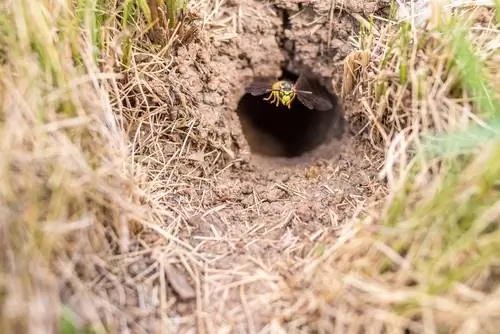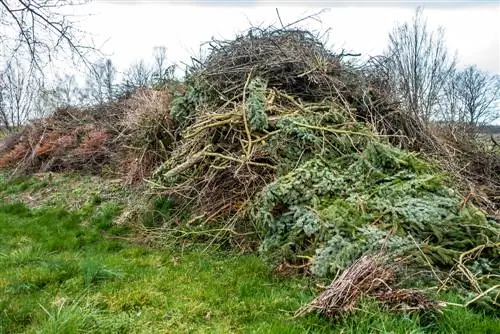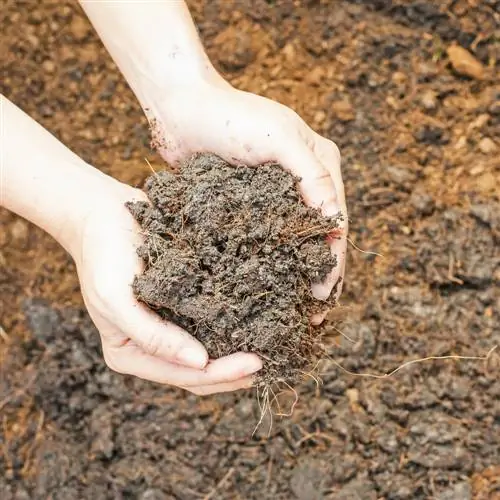- Author admin [email protected].
- Public 2023-12-16 16:46.
- Last modified 2025-06-01 06:02.
A self-made house and garden builder has to keep an eye on numerous tasks so that the costs don't get out of hand. This includes a cheap solution to the vexing question: What to do with the excavation? This guide provides a constructive overview of how you can correctly determine disposal costs and put the brakes on costs.

How much does it cost to dispose of excavated earth?
The disposal of excavated earth costs an average of 40 euros per cubic meter, including container rental and landfill fees. Excavated soil contains earth, clay soil, topsoil, sand and small stones, without asph alt, gravel or contaminated soil. 1 cubic meter of excavated earth weighs about 1 ton.
- The disposal of excavated earth costs an average of 40 euros per cubic meter, including container rental and landfill fees.
- Excavated earth according to legal classification contains earth, clay soil, topsoil, sand and small stones. No excavation in the legal sense is excavation mixed with building rubble, turf, roots, asph alt, gravel and contaminated soil.
- 1 cubic meter of excavated earth weighs approximately 1000 kilograms (1 ton), depending on density, moisture and composition.
Disposing of excavated earth - costs at a glance
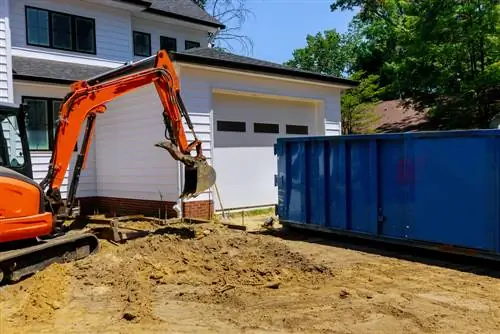
The cost of excavating the earth depends on various factors
Excavation occurs in many small and large construction projects. For cellars, floor slabs, underground tanks, cisterns or swimming ponds, soil is taken from the ground and is usually not returned in full. The question now facing builders is: How and where can excavated earth be disposed of inexpensively? The following table provides an overview of proven options and indicates average prices:
| Posts | Container self-filling 10 m³ | Container external filling 10 m³ | Truck self-filling 100 m³ |
|---|---|---|---|
| Containers (rental, removal) | 180-250 EUR | 120-150 EUR (rental only) | 800-1000 EUR |
| Fill container/truck | not applicable | 200-250 EUR (loading) | 180-300 EUR (mini excavator) |
| Landfill fees | 100-150 EUR | 100-150 EUR | 1000-1500 EUR |
| Total | 280-400 EUR | 420-550 EUR | 1980-2800 EUR |
| Costs per m³ | 28-40 EUR | 42-55 EUR | 19, 80-28 EUR |
| Cost per ton | 28-40 EUR | 42-55 EUR | 19, 80-28 EUR |
Please note: This overview does not claim to be representative price statistics, but rather presents a rough framework for typical excavation costs for small and large quantities, broken down to the costs per m3 and per ton. In Germany there are significant fluctuations between prices in rural regions and metropolitan areas. The acute landfill shortage is causing landfill fees to explode locally, as recently happened in the greater Stuttgart area as a result of the tunnel construction for Stuttgart 21 from an average of 10 to 15 euros to a dizzying 50 euros per ton of excavated earth.
How much does a cubic meter of excavated earth weigh?
In Germany, certified landfills are responsible for receiving classic mass waste from the private and commercial construction sector. If you dispose of excavated earth at a regional landfill, the costs are calculated per ton. Fortunately, no mathematical pull-ups are required to determine the weight of excavated earth:
- 1 cubic meter of excavated earth weighs 900 to 1000 kilograms, depending on moisture, density and composition
- Rule of thumb: 1 cubic meter of excavated earth weighs 1 ton
If you have the excavated earth picked up by a company and do not dispose of it yourself, any landfill fees incurred are usually included in the flat rate. The prices per ton are at a low level compared to other waste charges, such as hazardous waste, because landfills only temporarily store excavated earth and reuse it for various construction projects, such as landfilling.
Excursus
Topsoil - natural treasure in excavated earth
As a finite resource, topsoil is subject to special legal protection. Section 202 of the Building Code stipulates that topsoil must be maintained in a usable condition and protected from being wasted or destroyed. In fact, pure mother earth is teeming with life. Myriads of busy microorganisms produce valuable humus, the basis for plant growth. For this reason, it is a matter of course for builders and hobby gardeners to separate topsoil from excavated soil in order to create magnificent flower borders and productive vegetable beds.
What is excavation? - Classification at a glance
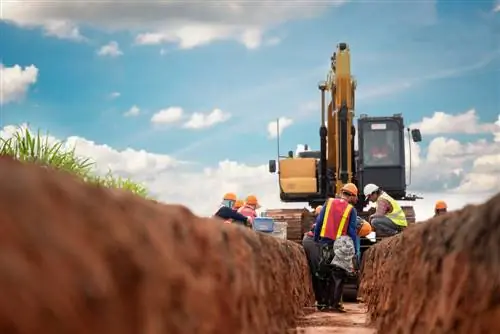
The top layer of earth does not count as excavated earth
Not everything that comes to light when digging a pit is excavated earth in the legal sense. The top layer of soil is usually excluded. House construction usually involves soil contaminated with foreign materials. Experience has shown that excavation in the garden begins under a layer of protected topsoil. A rule of thumb that has proven itself in practice is to only dispose of the soil as excavated soil when it is 30 to 50 centimeters deep. Because a building owner is responsible for the correct classification, the following table provides an overview:
| Excavation | no excavation |
|---|---|
| Earth | Asph alt |
| clay soil | old wood |
| Topsoil | Construction rubble |
| clay soil | Masonry |
| Sand | gravel |
| Sandy soil | Plant remains |
| small stones | Roots |
| Grass soil without sod | Sod |
Topsoil mixed with roots, plant residues or turf is far too good to be disposed of in the landfill. Clever builders decide to prepare suitable excavated earth on site and in doing so significantly reduce costs. For this purpose, smaller amounts of soil are separated from impurities using a sieve. The following video shows how the plan works with a high-performance vibrating screen on a new building site:


Calculate excavated quantity
If a builder understands the precise calculation of quantities when excavating the earth, there will be no rude awakening later when it comes to the costs of removal and disposal. In fact, the volume calculation goes well beyond the size of the building object. If an underground tank with a capacity of 50 m³ is sunk into the ground, twice as much earth has to be excavated, of which around two thirds have to be disposed of. The following example calculation explains how to correctly calculate excavated earth:
Calculate the amount of earth excavated for the basement
A 3 m deep pit is dug for a cellar measuring 15 m long and 10 m wide. To determine the amount of earth to be excavated, 2 m must be added all around for thermal insulation, drainage and movement space. This results in the following calculation:
- (15 m length + 2 m + 2 m) x (10 m width + 2 m + 2 m) x 3 m depth=19 m x 14 m x 3 m=798 m³ total excavated earth
- of which to be disposed of: 2/3 of 798 m³=532 m³
If you calculate the prices for excavated earth disposal with a sharp pencil, the loosening factor rounds off this formula in a useful way. The loosening factor takes into account the ratio of undissolved soil to dissolved soil when calculating the volume. Experience has shown that excavation work increases the volume of the earth by 15 to 25 percent (average 20 percent), which corresponds to a percentage factor of 1.20. By multiplying the calculated amount by 1.20, the larger volume is inevitably included in the calculation occurs when digging, excavating or excavating. In the example calculation above, the loosening factor is reflected as follows:
- 798 m³ excavated earth x 1, 20 loosening factor=957 m³
- of which to be disposed of: 2/3 of 957 m³=638 m³
Tip
Saving hunters know how to dispose of excavated earth for free. Small quantities of up to 10 cubic meters of excavated material from a pit can quickly find a buyer. A free classified ad brings providers and interested parties together. For pure topsoil, there are topsoil exchanges on the Internet where builders can also get rid of the excavated soil for free.
Rent a container or borrow a truck?
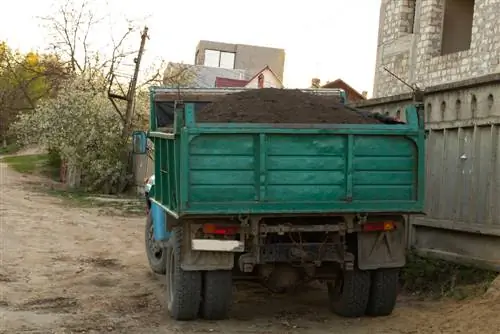
Whether a truck is worthwhile depends on the amount to be excavated
The volume of soil to be disposed of determines whether a container is sufficient for excavation or whether a truck is used. In practice, a magic limit of 30 cubic meters has proven to work well. Trough containers with a capacity of 7 to 10 cubic meters and a correspondingly small space requirement are practical for the hobby gardener who has dug a small pit by hand. Larger containers hold 20 to 30 cubic meters of excavated earth and can remain on the property for up to 14 days to ensure stress-free filling.
Excavation for the basement or a floor slab, on the other hand, produces excavated earth in quantities of several hundred cubic meters, which makes the use of a truck unavoidable. Because the downtime is usually limited to one day or a weekend at most, we recommend renting a mini excavator to shovel the excavated earth onto the loading area.
Frequently asked questions
Where can you dispose of excavated earth?
There are various options available for disposing of excavated earth. Disposal is free as part of reuse when building a terrace, as a base for a herb spiral without similar garden projects. Pure topsoil is ideal for creating a lawn or vegetable garden. You can hand over excess excavated earth free of charge to those who collect it themselves. Any quantities beyond this must be disposed of at a municipal or commercial landfill.
How much does it cost to excavate earth for the basement of a single-family home by a civil engineering company, including removal and disposal?
Civil engineering companies in Germany estimate an average of 40 euros per cubic meter for the mechanical excavation of a basement pit with medium-heavy soil. In the rare case that the soil is light, sandy and loose, the price drops to 16 to 20 euros per cubic meter. Rocky excavation drives up costs to 80 to 90 euros per cubic meter. The price includes all work, from preparing and filling the truck to transport and disposal at the landfill.
Can you store excavated earth on the property?
In Germany it is permitted to store the excavated earth from a construction pit on the construction site, provided the earth is intended for further use. The prerequisite is that it is excavated earth in the legal sense and not contaminated soil from an area suspected of being contaminated. However, permanent storage of excavated earth is not permitted. In accordance with legal requirements, any excavated soil that cannot be used as building material on this or another construction site must be disposed of.
Tip
Earth excavation according to legal classification is perfect for filling and straightening property or garden. Beforehand, the topsoil is excavated to a depth of around 30 centimeters and piled up separately. Excavated earth acts as a rough subgrade and drainage layer. Topsoil serves as the fine subsoil, providing ideal growth conditions for plants and lawns.


